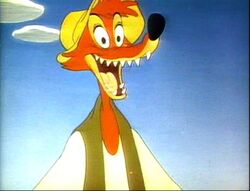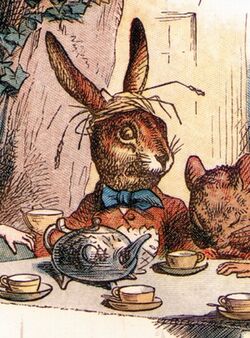
Br'er Fox is an anthropomorphic fox featured in the Br'er Rabbit stories told by Uncle Remus.
Anthropomorphism is a term coined in the mid 1700s to refer to any attribution of human characteristics (or characteristics assumed or believed by some to belong only to humans) to animals or non-living things, phenomena, material states and objects or abstract concepts. Examples include animals and plants and forces of nature such as winds, rain or the sun depicted as creatures with human motivations, and/or the abilities to reason and converse. The term derives from the combination of the Greek ἄνθρωπος (ánthrōpos), "human" and μορφή (morphē), "shape" or "form".
As a literary device, anthropomorphism is strongly associated with art and storytelling where it has ancient roots. Most cultures possess a long-standing fable tradition with anthropomorphised animals as characters that can stand as commonly recognised types of human behavior.
Prehistory[]
From the beginnings of human behavioural modernity in the Upper Paleolithic, about 40,000 years ago, examples of zoomorphic (animal-shaped) works of art occur that may represent the earliest evidence we have of anthropomorphism. One of the oldest known is an ivory sculpture, the Lion man of the Hohlenstein Stadel, Germany, a human-shaped figurine with a lion's head, determined to be about 32,000 years old.
It is not possible to say what exactly these prehistoric artworks represent. A more recent example is The Sorcerer, an enigmatic cave painting from the Trois-Frères Cave, Ariège, France: the figure's significance is unknown, but it is usually interpreted as some kind of great spirit or master of the animals. In either case there is an element of anthropomorphism.
This anthropomorphic art has been linked by archaeologist Steven Mithen with the emergence of more systematic hunting practices in the Upper Palaeolithic (Mithen 1998). He proposes that these are the product of a change in the architecture of the human mind, an increasing fluidity between the natural history and social intelligences, where anthropomorphism allowed hunters to empathetically identify with hunted animals and better predict their movements.
In religion and mythology[]
In religion and mythology, anthropomorphism refers to the perception of a divine being or beings in human form, or the recognition of human qualities in these beings. Many mythologies are concerned with anthropomorphic deities who express human characteristics such as jealousy, hatred, or love. The Greek gods, such as Zeus and Apollo, were often depicted in human form exhibiting human traits. Anthropomorphism in this case is referred to as anthropotheism.
Numerous sects throughout history have been called anthropomorphites attributing such things as hands and eyes to God, including a sect in Egypt in the 4th century, and a 10th-century sect, who literally interpreted Genesis 1:27: "So God created man in His own image, in the image of God He created him; male and female He created them".
From the perspective of adherents to religions in which humans were created in the form of the divine, the phenomenon may be considered theomorphism, or the giving of divine qualities to humans.
In Genesis 1&2[]
The accounts in the Hebrew Bible of the creation located in the first book of the Torah named Genesis often give anthropomorphic qualities to the Deity credited for creation. “The Lord God is down to earth, immanent, and described in vividly anthropomorphic language.” Examples of these anthropomorphism of God are instances such as “and God said…” which would allude to the deity speaking like a human would. Perhaps a clearer example would be from the second creation account found in Genesis 2:7 when it speaks to the notion that God created man from the dust of the ground. In essence, this gives God a pair of hands, another human characteristic. Verse 7 also alludes to the idea that God “breathed into his nostrils the breath of life” giving God a mouth and oxygen to breath into a human to produce life. “he is formed form the dust of the ground rather than created in the image of God. Formed suggests an act of physical molding, as a potter forms clay.”[9] Much of this text is used as the basis for creationism.
Criticism[]
Some religions, scholars, and philosophers found objections to anthropomorphic deities. The Greek philosopher Xenophanes (570–480 BC) said that "the greatest god" resembles man "neither in form nor in mind". Anthropomorphism of God is rejected by Judaism and Islam, which both believe that God is beyond human limits of physical comprehension. Judaism's rejection grew during the Hasmonean period (circa 300 BC) due to Greek philosophy becoming incorporated in Jewish belief. Judaism's rejection grew further following the Muslim Renaissance (10 century BC) later codified in 13 principles of Jewish faith authored by Maimonides in the 12th Century.
Hindus do not reject the concept of God in the abstract unmanifested but note problems; Lord Krishna said in the Bhagavad Gita, Chapter 12, Verse 5, that it is much more difficult to focus on God as the unmanifested than God with form, i.e., using anthropomorphic icons (murtis), due to human beings having the need to perceive via the senses.
In his book Faces in the Clouds: A New Theory of Religion, Stewart Elliott Guthrie theorizes that all religions are anthropomorphisms that originate due to the brain's tendency to detect the presence or vestiges of other humans in natural phenomena.
In literature[]
Fables[]
Anthropomorphism, sometimes referred to as personification, is a well established literary device from ancient times. It extends back to before Aesop's Fables in 6th century BC Greece and the collections of linked fables from India, the Jataka Tales and Panchatantra, which employ anthropomorphised animals to illustrate principles of life. Many of the stereotypes of animals that are recognised today, such as the wiley fox and the proud lion, can be found in these collections. Aesop's anthropomorphisms were so familiar by the 1st century AD that they coloured the thinking of at least one philosopher:
"And there is another charm about him, namely, that he puts animals in a pleasing light and makes them interesting to mankind. For after being brought up from childhood with these stories, and after being as it were nursed by them from babyhood, we acquire certain opinions of the several animals and think of some of them as royal animals, of others as silly, of others as witty, and others as innocent."
- Apollonius of Tyana
Apollonius noted that the fable was created to teach wisdom through fictions that are meant to be taken as fictions, contrasting them favourably with the poets' stories of the gods that are sometimes taken literally. Aesop, "by announcing a story which everyone knows not to be true, told the truth by the very fact that he did not claim to be relating real events". The same consciousness of the fable as fiction is to be found in other examples across the world, one example being a traditional Ashanti way of beginning tales of the anthropomorphic trickster-spider Anansi: "We do not really mean, we do not really mean that what we are about to say is true. A story, a story; let it come, let it go."
Fairy Tales[]
Anthropomorphic motifs have been common in fairy tales from the earliest ancient examples set in a mythological context to the great collections of the Brothers Grimm and Perrault. The Tale of Two Brothers (Egypt, 13th century BC) features several talking cows and in Cupid and Psyche (Rome, 2nd century AD) Zephyrus, the west wind, carries Psyche away. Later an ant feels sorry for her and helps her in her quest.
Modern literature[]

John Tenniel's depiction of the March Hare was featured in the seventh chapter of Lewis Carroll's Alice's Adventures in Wonderland.
Building on the popularity of fables and fairy tales, specifically children's literature began to emerge in the 19th century with works such as Alice's Adventures in Wonderland (1865) by Lewis Carroll, The Adventures of Pinocchio (1883) by Carlo Collodi and The Jungle Book (1894) by Rudyard Kipling, all employing anthropomorphic elements. This continued in the 20th century with many of the most popular titles having anthropomorphic characters, examples being The Tales of Beatrix Potter (1901 onwards), The Wind in the Willows (1908) by Kenneth Grahame, The Lion, the Witch and the Wardrobe by C. S. Lewis and Winnie-the-Pooh (1926) by A. A. Milne. In many of these stories the animals can be seen as representing facets of human personality and character. As John Rowe Townsend remarks, discussing The Jungle Book in which the boy Mowgli must rely on his new friends the bear Baloo and the black panther Bagheera, "The world of the jungle is in fact both itself and our world as well". Another notable work is George Orwell's Animal Farm.
The fantasy genre developed from mythological, fairy tale and Romance motifs and characters, sometimes with anthropomorphic animals. The best-selling examples of the genre are The Hobbit (1937) and The Lord of the Rings (1954–1955), both by J. R. R. Tolkien, books peopled with talking creatures such as ravens, spiders and the dragon Smaug and a multitude of anthropomorphic goblins and elves. John D. Rateliff calls this the "Doctor Dolittle Theme" in his book The History of the Hobbit and Tolkien saw this anthropomorphism as closely linked to the emergence of human language and myth: "...The first men to talk of 'trees and stars' saw things very differently. To them, the world was alive with mythological beings... To them the whole of creation was "myth-woven and elf-patterned".
In the 20th century, the children's picture book market expanded massively. Perhaps a majority of picture books have some kind of anthropomorphism, with popular examples being The Very Hungry Caterpillar (1969) by Eric Carle and The Gruffalo (1999) by Julia Donaldson.
From the 1960's through the 1990's, anthropomorphism has also been involved in various animated TV shows such as "Biker Mice From Mars" and "SWAT Kats: The Radical Squadron".
In the mid-2000's, a Canadian-New Zealand-American animated TV show called "Turbo Dogs" starred anthro dog characters. In 2010, a French-American animated TV show "The Mysteries of Alfred Hedgehog" was entirely consisted of woodland anthropomorphic characters.
The upcoming 2011 animated Hindi remake of the 1998 film "Kuch Kuch Hota Hai": "Koochie Koochie Hota Hain" will consist of three anthropomorphic dogs (one female and two males) and the supporting cast of anthro farm animals.